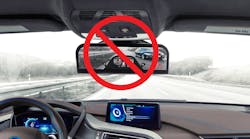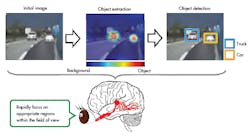Mitsubishi’s Object-Recognition Camera Technology Focused on Mirrorless Cars
In 2016, Japanese and European automakers got the okay to begin producing mirrorless cars. In such automobiles, rearview and side mirrors are replaced with camera-monitoring systems that stream high-resolution video to a display inside the vehicle. Unlike current rearview mirrors, the camera-based systems eliminate blind spots.
Moving to mirrorless systems also will allow automakers to become more creative with car designs. Certainly, aerodynamics improve by eliminating side-view mirror pods, enabling cars to deliver better fuel efficiency at high speeds with less wind and road noise.
Next year, the first commercial mirrorless cars are expected to launch in Japan. These mirrorless cars are likely to use object-recognition systems to alert drivers to dangerous situations by detecting and identifying objects in the live video captured with their on-board cameras. As a result, they’re expected to help prevent accidents, especially when changing lanes.
1. Mitsubishi’s Maisart AI-based camera system has a range of about 100 m.
This week, Mitsubishi Electric Corp. introduced what it believes to be the industry’s highest-performing automotive camera technology, able to detect various object types (it can distinguish between pedestrians, cars, and motorcycles) at distances of up to about 100 meters (Fig. 1).
Mitsubishi’s solution is based on its proprietary Maisart-brand artificial-intelligence (AI) technology (Maisart is an abbreviation for “Mitsubishi Electric's AI creates the State-of-the-ART in technology”). Maisart encompasses all of Mitsubishi Electric's proprietary AI technology, including its compact AI, automated-design, deep-learning algorithm and efficient smart learning.
The proposed technology employs a new computational visual-cognition model that mimics human visual behavior to rapidly focus on appropriate regions within the field of view (Fig. 2).
2. Maisart technology can distinguish between cars, trucks, and pedestrians.
Compared to conventional camera-based systems, Maisart technology is said to significantly extend the maximum distance of object detection from about 30 meters to 100 meters, as well as improve object-detection accuracy from 14% to 81%. Maisart enables compact AI for low-cost devices, according to the company, and employs what’s described as “relatively simple algorithms that free system resources for real-time performance, even in on-board systems.” The technology is covered by four patents in Japan and four outside of Japan.
Going forward, Mitsubishi engineers will be trying to develop more robust AI camera performance, particularly when a vehicle is driving in bad weather, at night, and on winding roads. The company also says it will be trying to increase object-recognition accuracy by using what’s called time-series information. In many real-world applications (for example, speech recognition), data is captured over the course of time, i.e., sequences of measurements that follow non-random order. With the advent of deep learning, new models of unsupervised learning of features in time-series analysis and forecast have been developed. Also, neural networks have proven to be very effective at analyzing this data.



